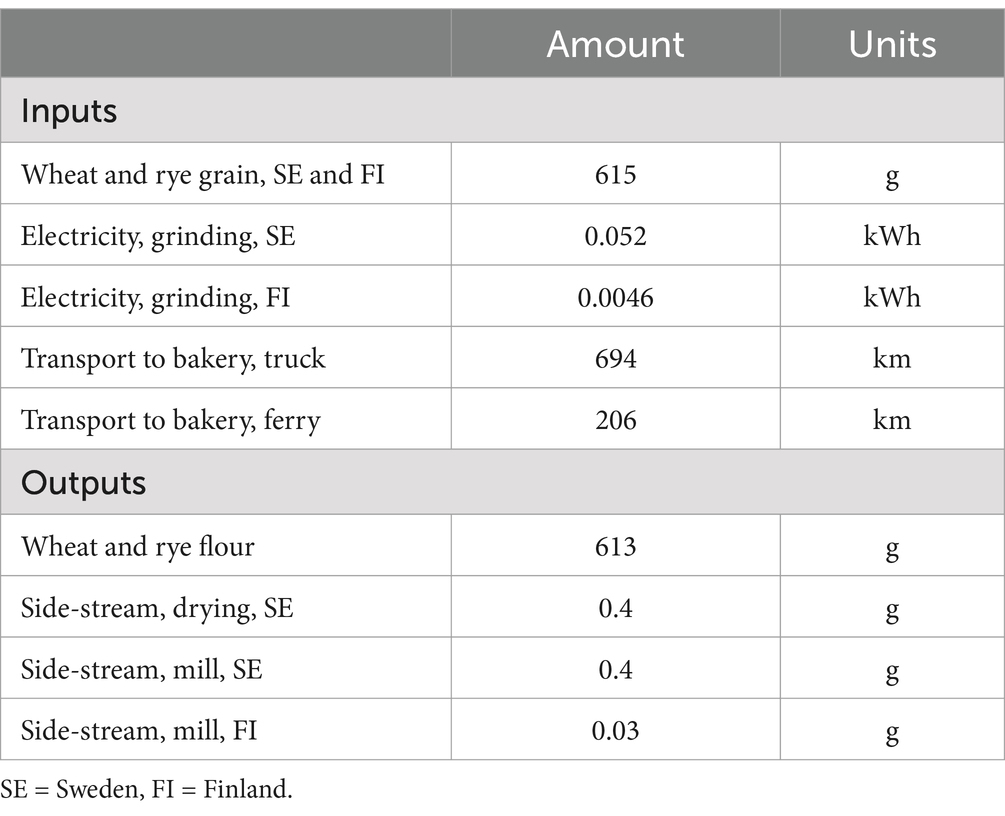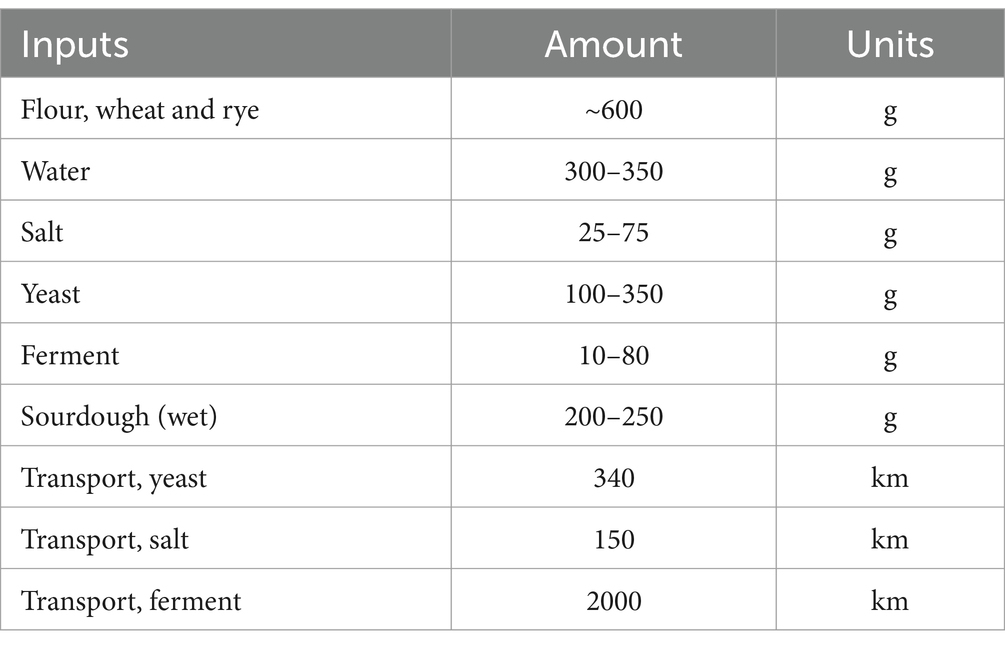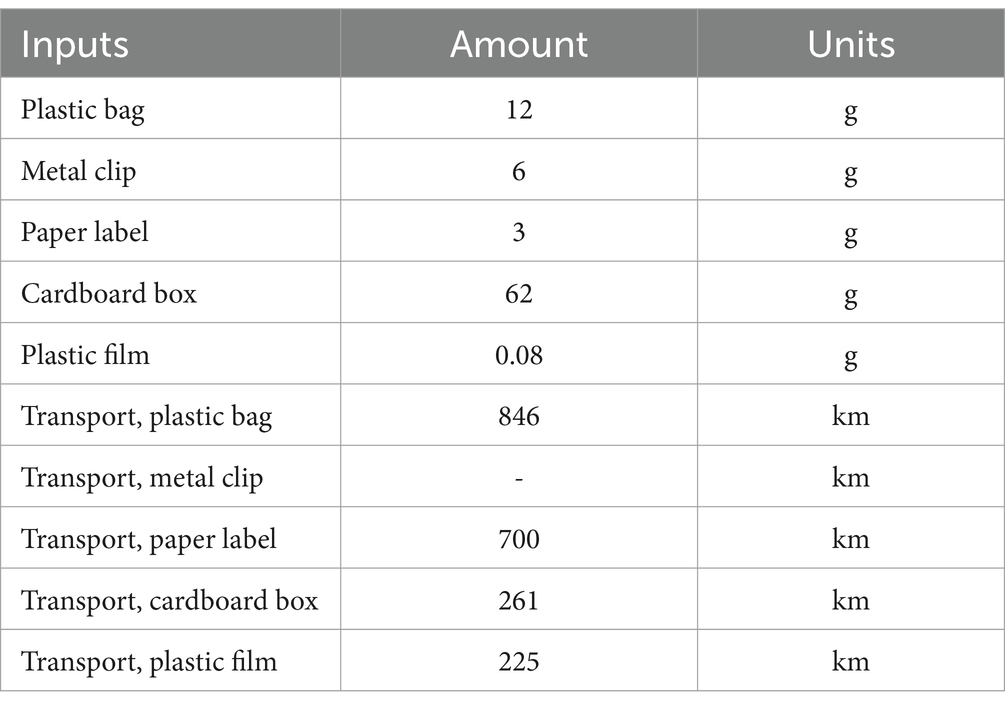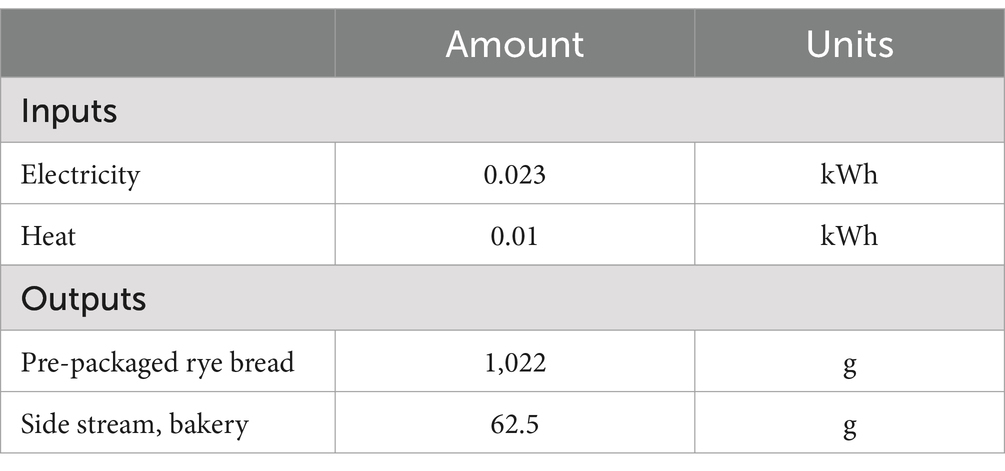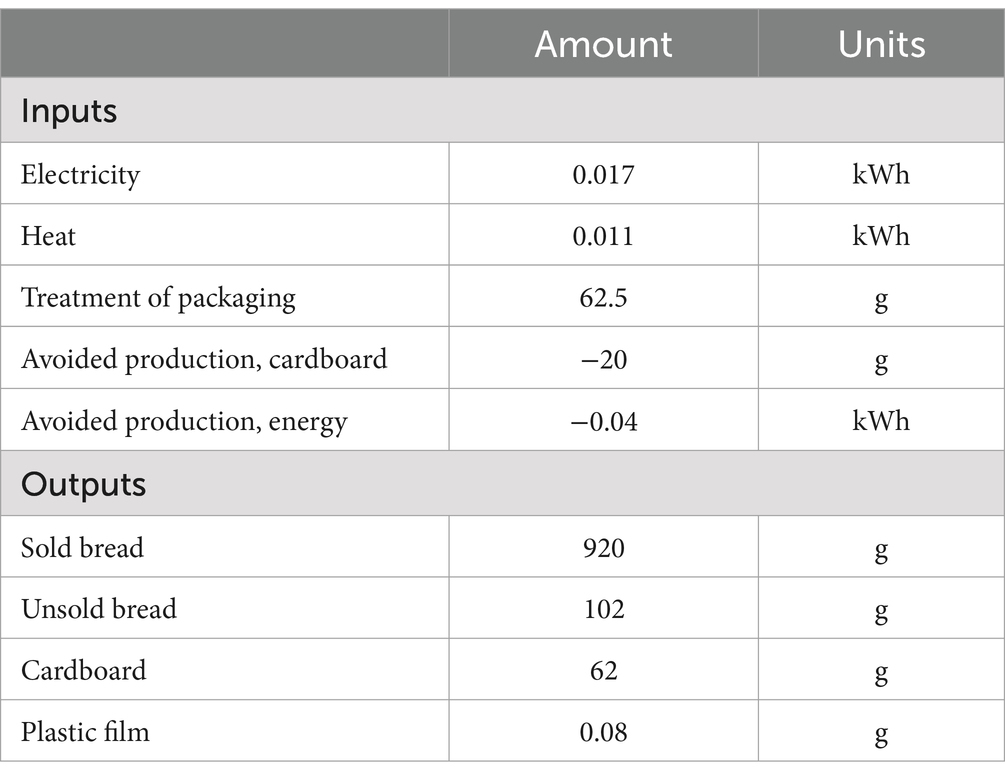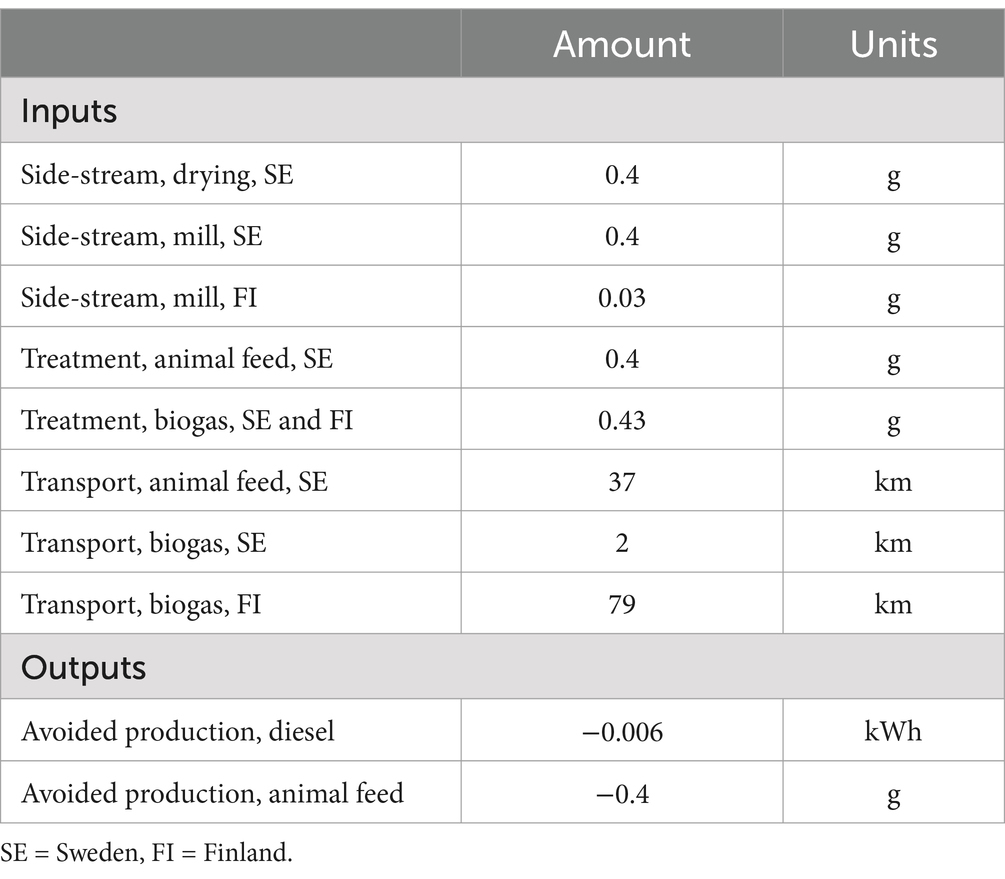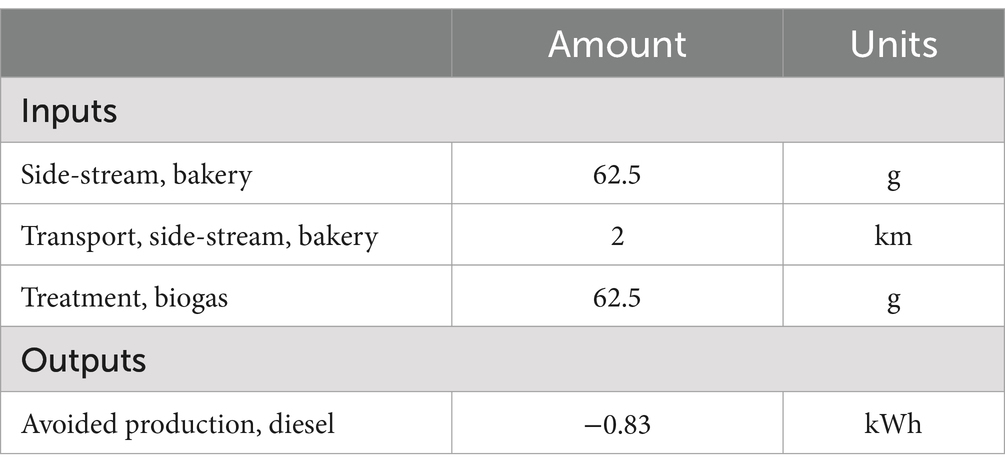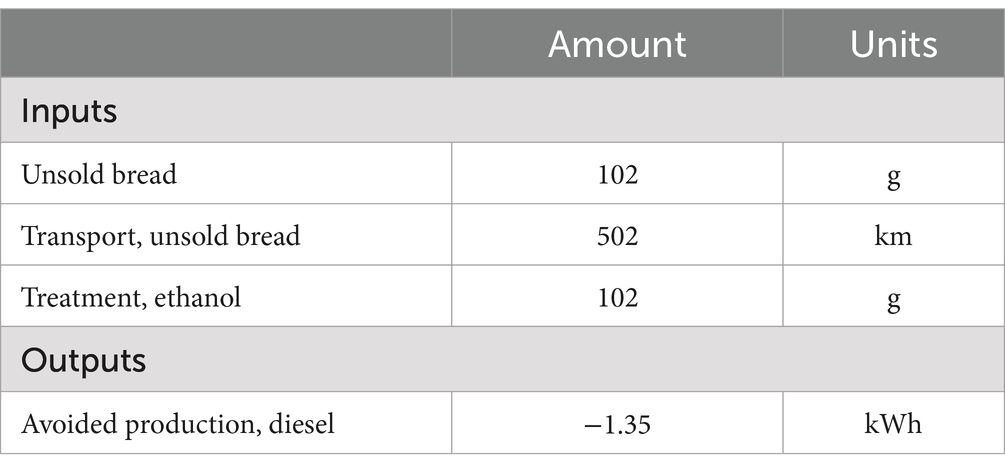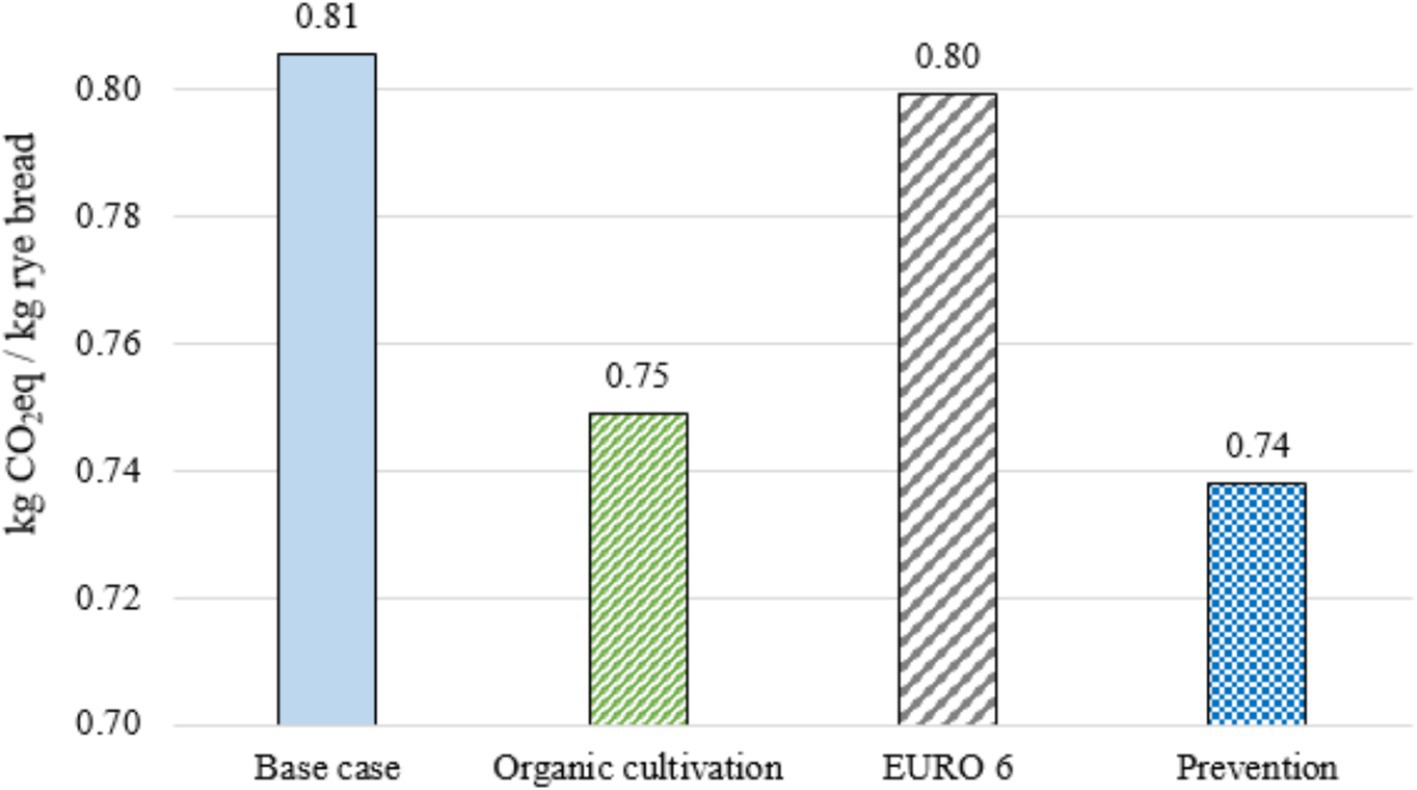- 1Department of Energy and Technology, Swedish University of Agricultural Sciences, Uppsala, Sweden
- 2Department of Resource Recovery and Building Technology, University of Borås, Borås, Sweden
The current food system contributes strongly to environmental pressure, with bread, a staple product in many countries, being consumed and wasted in substantial quantities. This study assessed the environmental impact of rye bread produced in Sweden using life cycle assessment (LCA), with the aim of identifying ways to reduce this impact. A unique aspect of this work was the independent collaboration between research and industry, which provided a highly representative description of the Swedish rye bread production and distribution system. The climate impact of rye bread was found to be 0.81 kg CO2eq per kg, with production of ingredients being the main hotspot for all impact categories assessed. In simulations of impact reduction pathways, the highest climate savings were found for prevention of surplus generated at bakery and retail, which reduced the climate impact by 8%. Using the standardised ReCiPe method, accounting for 18 midpoint impact categories and three damage indicators at endpoint, yielded vital insights into otherwise often overlooked environmental aspects of food production. By using data provided by an industry actor, the results from this study enabled in-depth mapping of the resources required to produce rye bread at industrial level in Sweden, providing unique insights into production. These results can act as an essential cornerstone for future research and development of sustainable food systems.
1 Introduction
The current food system is a key driver of environmental pressure (United Nations Environment Programme, 2024), especially since much of the food produced is wasted (de los Mozos et al., 2020). This imbalance between production and consumption poses a major risk of further damage to the planet, especially with escalating food demand due to population growth and economic development. Meeting these demands without transgressing planetary boundaries is a major challenge (Steffen et al., 2015; Rockström et al., 2020). This indicates the importance of a sustainable food system where present and future needs are balanced with respect to economic and social development and environmental protection. Several environmental impacts are linked to production of food, e.g., around 25% of the world’s greenhouse gas emissions originate from food production (Poore and Nemecek, 2018) and it also requires large volumes of water (Mekonnen and Gerbens-Leenes, 2020). Further, agriculture requires large areas of land, with half of the world’s habitable land used for agriculture, resulting in decreased biodiversity (Crenna et al., 2019; Ritchie et al., 2024). Food production and processing methods influence the environment, so multiple synergistic actions are needed to facilitate the change required. These range from improvements in technologies to reduced losses and wastage of food, in parallel with transition towards plant-based diets (Springmann et al., 2018; Kustar and Patino-Echeverri, 2021). On researching sustainable food supply chains via efficient resource use, Heydari (2024) identified multiple curtail research gaps. For instance, they highlight the need for focused studies targeting specific regions and aspects of food supply management, alongside a lack in collaborative efforts on multiple scales to alleviate data gaps and support development of resource efficient food systems.
Today, bread is a staple food in many parts of the world, including Sweden, and is available in many shapes, sizes and flavours (Notarnicola et al., 2017). In many parts of Europe bread is an important source of carbohydrates (Cust et al., 2009), while in Scandinavia it is a major source of dietary whole grain (Kyrø et al., 2012). In the Nordic countries, bread consumption is deeply rooted in tradition and food culture (Jensen and Arlbjørn, 2014), and the nutrition recommendations include increased consumption of whole grain since it is linked to several health benefits (Blomhoff et al., 2023). In Sweden, the average consumption of soft, savoury bread was 2023 roughly 51 kg per capita (Jordbruksverket, 2023), where the most consumed bread type is pre-packaged bread using wheat or a combination of wheat and rye flour. Being a staple product in many homes, whole-grain bread can therefore play an important role in future healthy and sustainable diets. Additionally, Kramer et al. (2018) suggested that introducing more bread could reduce some of the environmental burden relating to a nutritionally balanced diet, which was also voiced in a later study by Cassarino et al. (2024). The environmental impact attributed to bread produced using whole-grain in the Nordic countries still presents an important research gap. Moreover, bread that is wasted instead of consumed inevitably impose a crucial toll on the environment including greenhouse gas emissions and biodiversity loss (United Nations Environment Programme, 2024), regardless of the ingredients used. Bread is associated with high levels of surplus and waste along the supply chain (Brancoli et al., 2019; Goryńska-Goldmann, 2022), and the environmental impact of food production is greater when food is wasted instead of consumed (Poore and Nemecek, 2018; Scherhaufer et al., 2020). On assessing the priorities for food system transformations, Gibson and Gibson (2024) highlight that industry actors are fundamental for obtaining change within food systems. Environmental impact of whole-grain bread, accounting for the losses and waste along the supply chain, is therefore of upmost importance to gain a holistic view on how bread can contribute to sustainable food systems. By mapping the production system and identifying where waste occur, alongside the environmental burden related to the management of this waste, more targeted mitigation strategies could be developed by industry and actors within the bread supply chain.
Moores et al. (2025) discussed limitations related adaptation of available circularity assessment methods research, but also highlighted that one of the most holistic methods from the sustainability and circularity perspective commonly used, is life cycle assessment (LCA). Previous research using LCA has identified multiple environmental hotspots along the bread supply chain, including cultivation (Goucher et al., 2017; Ingrao et al., 2018), distribution (Weber et al., 2023), baking (Braschkat et al., 2003; Jensen and Arlbjørn, 2014), alongside surplus and side-streams (Svanes et al., 2019). However, few studies assessing industrially baked bread are conducted using primary data obtained directly from the company responsible for production. This constitutes an important limitation, since the accuracy of input data is one of the most important cornerstones in LCA studies. Another factor influencing the environmental performance is the type of bread studied. Notarnicola et al. (2017) found that simple bread, produced using fewer ingredients, had lower impact compared to bread using, e.g., whole-grains, nuts or seeds, while Espinoza-Orias et al. (2011) showed that using resources more efficiently, as is often the case for whole-grain bread, also tend to yield lower environmental impacts. Similarly, management pathways used for surplus and unsold bread also influence the environmental performance, where prevention and high-value valorisation such as animal feed or ethanol production has been found to reduce the burden otherwise assigned to wastage of still edible bread (Brancoli et al., 2020). Another aspect important to consider is means required for distribution of bread, both with respect to transport and packaging (Sundkvist et al., 2001; Molina-Besch et al., 2019). Although some previous research has accounted for the environmental burden of packaging used for bread in the Scandinavian settings, for instance Svanes et al. (2019), to our knowledge this is still missing for the Swedish bread system. Since the majority of bread is sold pre-packaged in Sweden, quantifying the impact related to packaging is highly relevant.
To support resource efficient production and management of bread, it is important to consider local conditions in combination with large-scale environmental goals. The aim of the present study was therefore to, for the first time, map and quantify the production pathways of a whole-grain bread in Sweden. Via industry collaboration this study utilizes primary inventory data, shared by the company responsible for producing the bread, as input to the model. This study further aimed to identify hotspots for waste generation and environmental impact, in order to support industry development towards resource efficiency and less food waste. By using standardised LCA methods in accordance with the ISO 14040 (2006) standards, the environmental impact of rye bread assessed in this study can also serve as a foundation in future research and for targeted policy recommendations.
2 Material and method
This study was conducted in collaboration with Fazer Bageri AB and Fazer Sweden AB (Fazer Group), one of the largest food companies in the Nordic countries and a major producer of bakery and confectionery. The data used in the analysis were mainly gathered in 2022, using a qualitative interview approach, based on a personal conversation format, with Fazer representatives and distributors. Fazer bakeries supply around 20% of the Swedish market for pre-packaged bread (Fazer, 2022d), of which the product Rågkusar accounts for 2.4%. In terms of annual production, this represents sales of roughly 1,200 ton (or 2.4 million packs of bread) sold at retail using two different pack sizes. Rågkusar are rye bread rolls that consist mainly of rye fibre, whole-grain rye and wheat flour, with a whole-grain content of 69%. It is sold and distributed under a so-called take-back agreement (TBA) where the supplier and their distributor is responsible for production, distribution, delivery, management at retail, collection of unsold products and waste management (Eriksson et al., 2017). The goal of this study was to identify and evaluate potential improvements within the bread production and waste handling stages of production chain from an environmental point of view, in order to deepen understanding of the impacts associated with the lifecycle of bread and identify opportunities for improvements. The study assessed the environmental impact of 1 kg of rye bread, using the product Rågkusar as base case, considering all aspects from cradle to retail of the whole-grain bread and its packaging within the system boundaries (Figure 1).
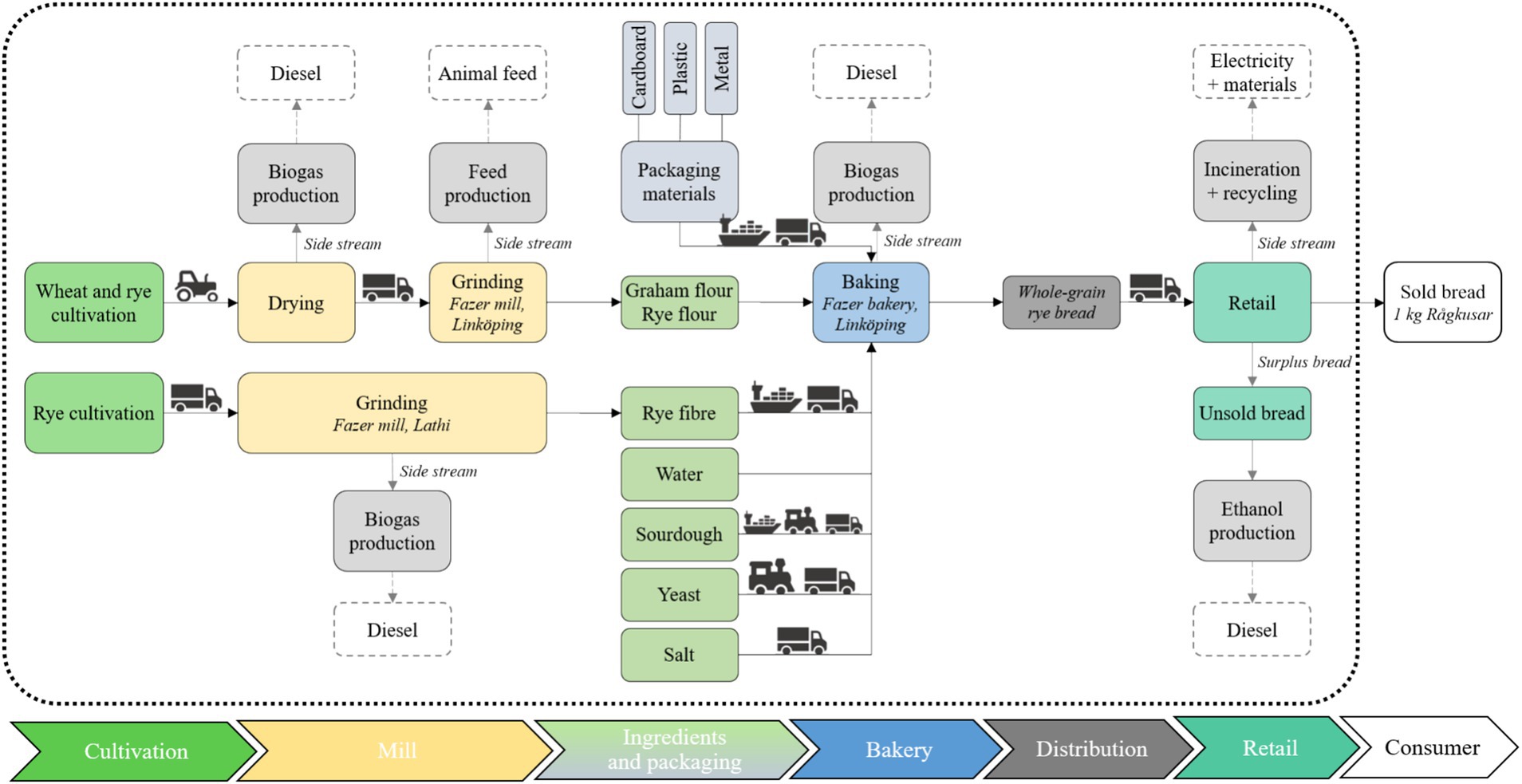
Figure 1. Flowchart showing the general pathways from cradle to retail of inputs and outputs required for production of bread (Rågkusar). The dotted line indicates the system boundary, the dashed line shows the substitution via system expansion.
End of life of packaging at retail was included in the analysis, while secondary packaging of ingredients and packing materials were excluded. Packaging materials that are reusable, e.g., pallets for transportation, were also outside the system boundaries. Moreover, the use phase at consumption level was outside the scope of the analysis, meaning that processes such as domestic bread consumption and consumer transport from retail was excluded in this study. Disposal of bread waste from production and retail was included in the system boundaries, while multifunctionality was dealt with using system expansion via substitution. The ReCiPe 2016, Hierarchist version, was used to assess environmental impact as it provides the broadest set of 18 midpoint impact categories, alongside three endpoint indicators. SimaPro 9.5 coupled with the databases Ecoinvent and Agri-footprint, to describe the system. Datasets used to for each process are available in Tables S1–S5.
2.1 Inventory analysis
2.1.1 Cultivation and milling
The wheat and rye flours used in production of Rågkusar are cultivated in southern Sweden, requiring inputs such as machinery, pesticides, fertilisers, fuel, energy and water that where accounted for via the datasets. After harvest, grain is transported approximately 10 km by tractor to a distributor that for drying and then a further 35 km to the mill. The rye fibre is produced in Finland, where the average transportation distance between the farm and the mill is 110 km (Fazer, 2022a). Table 1 shows inputs and outputs required during cultivation and transport of grain to the mill, calculated as the mean value from a range provided by Fazer.
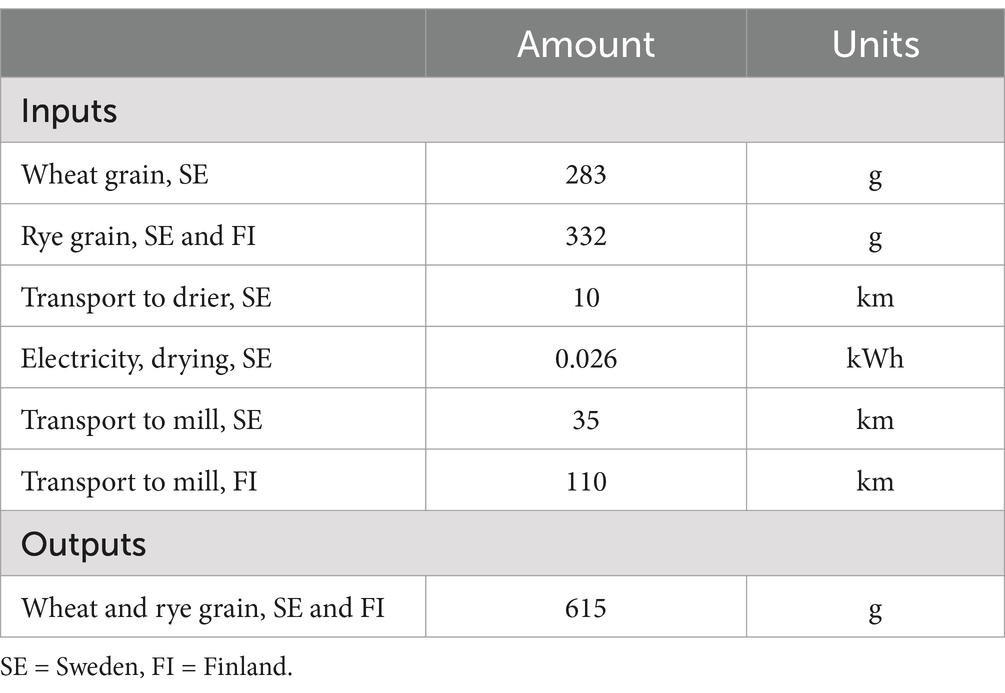
Table 1. Inputs and outputs used in cultivation, drying and transportation of grain for production of bread, expressed per kg bread.
On arriving at the Swedish mill, the moisture content of the wheat and rye grain is reduced, from 15–16% after harvest, to roughly 13% after drying. This process is fuelled mainly by a solid fuel burner. During the drying process, around 1.1 g per kg rye bread is lost via side-streams, of which 0.7 g goes into fuelling the process and the remaining 0.4 g goes to biogas production (Fazer, 2022a). In this study, the biogas produced from this side-stream was assumed to replace diesel. After drying at the Swedish grain storage facility, the grain is transported by truck to the mill. On arrival at the mill, a sample is taken to evaluate grain quality, after which the grain is run through a magnet to remove any metal items which may have been inadvertently introduced in previous steps. This process is followed by a pre-cleanse and storage. Finally, the grain is run through fine cleaning and then stored until needed, at which time it is run through a second magnet cleanse and milled into flour. The flour is tested, stored, and then transferred through a pipeline to the connecting bakery. All process stages are powered by electricity. The side-stream generated is roughly 0.4 g per kg, directed towards animal feed (Fazer, 2022a).
At the mill in Finland, a sample for quality assessment is taken from the rye grain in the truck. The grain is then unloaded and another sample is taken automatically to confirm grain quality. During intake, the grain is run through a pre-cleanse, including a magnet, and then stored in silos before being moved to specific mill silos, where the grain is run through a final cleanse. Rye bran is then milled into a fine fibre, which is analysed and packaged in bags for transport. The waste side-stream, consisting of rye kernels, dust, impurities etc., amounts to approximately 0.03 g and is directed towards biogas production, while transportation of flour to the bakery in Sweden is performed by truck and ferry. Table 2 show the average inputs and outputs required during milling operations in Sweden and Finland, calculated via the range in value provided by Fazer.
2.1.2 Ingredients, packaging and baking
The remaining ingredients needed (here simplified to yeast, sourdough starter, salt, wet sourdough) are transported to the bakery. The yeast is produced in Sweden, using raw materials from Europe, and transported in tanker trucks (Fazer’s Supplier, 2022c). The transportation distance was assumed here to be 400 km. The sourdough starter, also called ferment, is a dried sourdough sourced from Italy, which is transported to the bakery by intermodal transport covering a total distance of roughly 2000 km, of which 1,096 km by train, 232 km by ferry and 566 km by truck. The remaining 100 km relies solely on trucks (Fazer’s Supplier, 2022c). The salt is mined and produced in Denmark and transported 150 km by truck to the bakery (Fazer’s Supplier, 2022a). At the bakery, the salt is mixed with water to create a salt solution that consists of one-third salt and two-thirds water. The wet sourdough is produced at the bakery and regularly fed with rye flour and water (Fazer, 2022a). The exact ingredient list is company-confidential and not reported in this paper. Table 3 presents a range for each input used, but precise data were used in all calculations. The percentages assumed for ingredients were in accordance with previous research (Espinoza-Orias et al., 2011).
The ingredients are measured and mixed in a kneading machine, fermented, divided into shapes and baked. The bread is then cooled, sliced and packaged in plastic bags that are closed with a metal clip, labelled and packed into large cardboard boxes enclosed in plastic film (Fazer, 2022b). Rågkusar are sold in two pack sizes: six breads (338 g) and 12 breads (675 g). The materials and inputs needed for packaging are calculated based on the smaller pack size (Fazer, 2022a), see Table 4.
Renewable electricity is used in all steps at the bakery apart from the cooling process, which does not require additional energy inputs. Datasets representing the Swedish electricity mix and the national market mix for heating was used according to literature, while the amount of energy required during baking was supplied by Fazer. The amount of side stream generated during this stage was calculated given the range between 60–65 g surplus per kg rye bread. Inputs and outputs during bakery processing are shown in Table 5.
2.1.3 Distribution and retail
Rågkusar, like the majority of pre-packaged bread sold at retail in Sweden, are sold and distributed under TBAs that apply a reverse logistic approach. Around 96% of the finished bread is transported to a distribution hub (Hub) by truck. An average transportation distance of 280 km to the distribution site was assumed here, with 37% fuelled by HVO-diesel and 63% by fossil diesel. The distributor is responsible for final transport to retail. Without further storage, the bread is transported to retail over an average transportation distance of 222 km by truck, with 36% of this transport fuelled by HVO-diesel, 15% by RME-diesel and 49% by fossil diesel. To account for any additional stops during the return trip, the route distance was increased by 502 km in this study. However, return transport was assumed to carry only 20% of the original bread load by weight.
The remaining 4% of the finished bread is directed to a separate distribution hub for frozen bread (HubF), using refrigerated trucks for frozen goods (reefers) over 115 km distance. About 30% of this transport is powered by HVO-diesel fuel. At the distribution site, the bread is stored frozen, often only until the next day, although some can be stored for around a month (Fazer’s Supplier, 2022b). Here, an average 14 days of storage time for frozen rye bread was assumed, requiring electricity. The second and final transport stage for frozen bread is approximately 378 km from distribution hub to retail, using freezer trucks fuelled by 38% HVO-diesel. The return transportation for the trucks was assumed to be 493 km, again assuming only 20% of the original weight. All transportation required from bakery to retail is shown in Table 6.
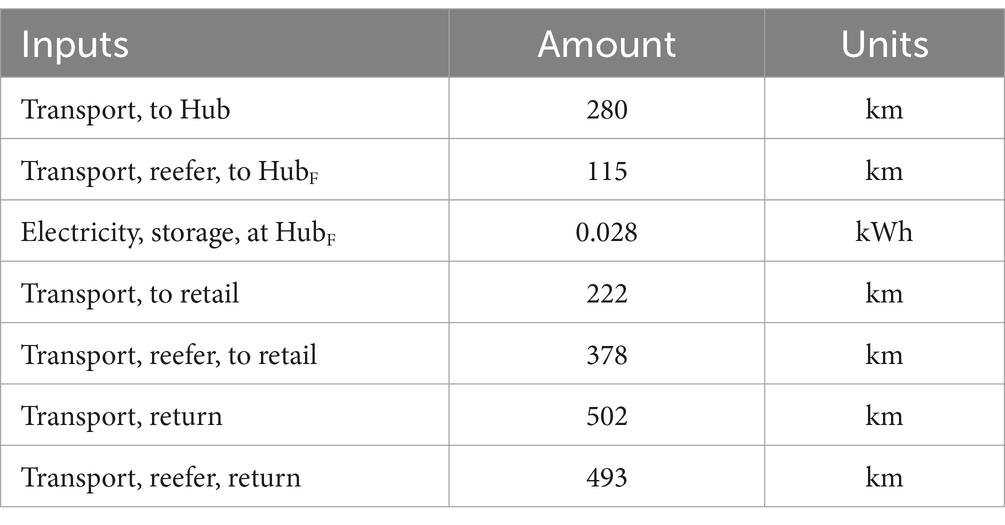
Table 6. Transportation required during distribution of rye bread from bakery to retail via distribution hubs.
At the retail site, the storage space for 1 kg rye bread was assumed to be 0.015 m2. The bread is usually sold after 2–6 days (Fazer, 2023), so an average retail storage time of 4 days was assumed. Electricity and heat are needed during the retail stage and were calculated based on occupied space. About 10% (100 g per kg) of rye bread delivered to retail is not sold to consumers, and instead handled as surplus. This bread is collected by the distributor separately from other food waste fractions generated at retail. The disposable packaging required during delivery to retail is also managed by the distributor, where the cardboard box is assumed to be recycled and the plastic film is dispatched to combustible waste for incineration. Inputs and outputs during the retail stage are presented in Table 7.
2.1.4 Management of side-steams and surplus bread
Transportation and management of side-streams and surplus bread generated along the supplier-retailer interface were mapped separately. Treatment of side-streams and surplus was included in the analysis, but additional losses and waste during treatment were assumed to be negligible. Avoided production of resources is presented as negative values in Tables 8–10, to illustrate the amount producible via valorisation. The side-streams generated during milling operations in Sweden are used in animal feed or biogas production via anaerobic digestion, while the side-stream generated in Finland is used solely for biogas production. Transportation needed for valorisation to animal feed was assumed to be 37 km, while only 2 km transport is required for side-streams directed to biogas production since a treatment facility is located close to the Fazer bakery in Linköping. About 79 km distance between mill and treatment facility was assumed for the side-stream generated in Finland. All biogas produced was assumed to replace fossil diesel.
The side-streams generated at the bakery originated from various process stages, including raw materials, dough, cleaning dust, baked unpackaged bread, pre-packaged bread and scrap packaging. The total amount of surplus, corresponding to roughly 6% of production, is directed towards biogas production via anaerobic digestion (Fazer, 2022a). The transport required was assumed to be 2 km, since a biogas facility is located close to the Fazer bakery in Linköping. The biogas produced was assumed to replace fossil diesel.
Roughly 99.5% of the surplus bread collected at retail is sent for valorisation via ethanol production in Norrköping (Fazer, 2023), with a transport distance of on average 502 km from bakery gate. The ethanol produced was assumed to replace fossil diesel.
2.2 Improvement analysis
Scenario analyses were conducted to assess the potential for improving production and distribution of whole-grain rye bread. These analyses considered factors such as organic cultivation, reduced emissions from transportation, and actions for preventing surplus generation at bakery and retail. The first scenario sought to evaluate the climate effect of grain cultivation system, since there are multiple important benefits associated with organic cultivation (Meier et al., 2015). In this scenario, organic cultivation datasets were used to model production of wheat and rye. A second scenario was designed to evaluate the influence of EURO transport class with consideration to Swedish rye bread, since higher class limits the emissions allowed. This was done by shifting from EURO 5 to EURO 6 for all datasets using road transport by truck. Lastly, a scenario was created to capture the potential benefits of reducing surplus generated at bakery and retail level. This was modelled using a prevention approach where all process stages from cultivation to retail are avoided. In this study, it was assumed that 50% of the current side-streams and surplus are preventable, while keeping the current pathways for the remaining 50%. Climate change, one of the most frequently assessed impact categories when evaluating the environmental sustainability of food (Vidergar et al., 2021), was the main focus in the scenario analyses.
3 Results
The environmental impact of 1 kg rye bread is shown in Table 11, while the contribution of each processes to the environmental impact is shown in Figure 2. Production of raw materials (cultivation, ingredients and packaging) was found to make the largest contribution to climate impact, where ingredients contributed 0.33 kg CO2eq, cultivation 0.27 kg CO2eq and packaging 0.17 kg CO2eq.
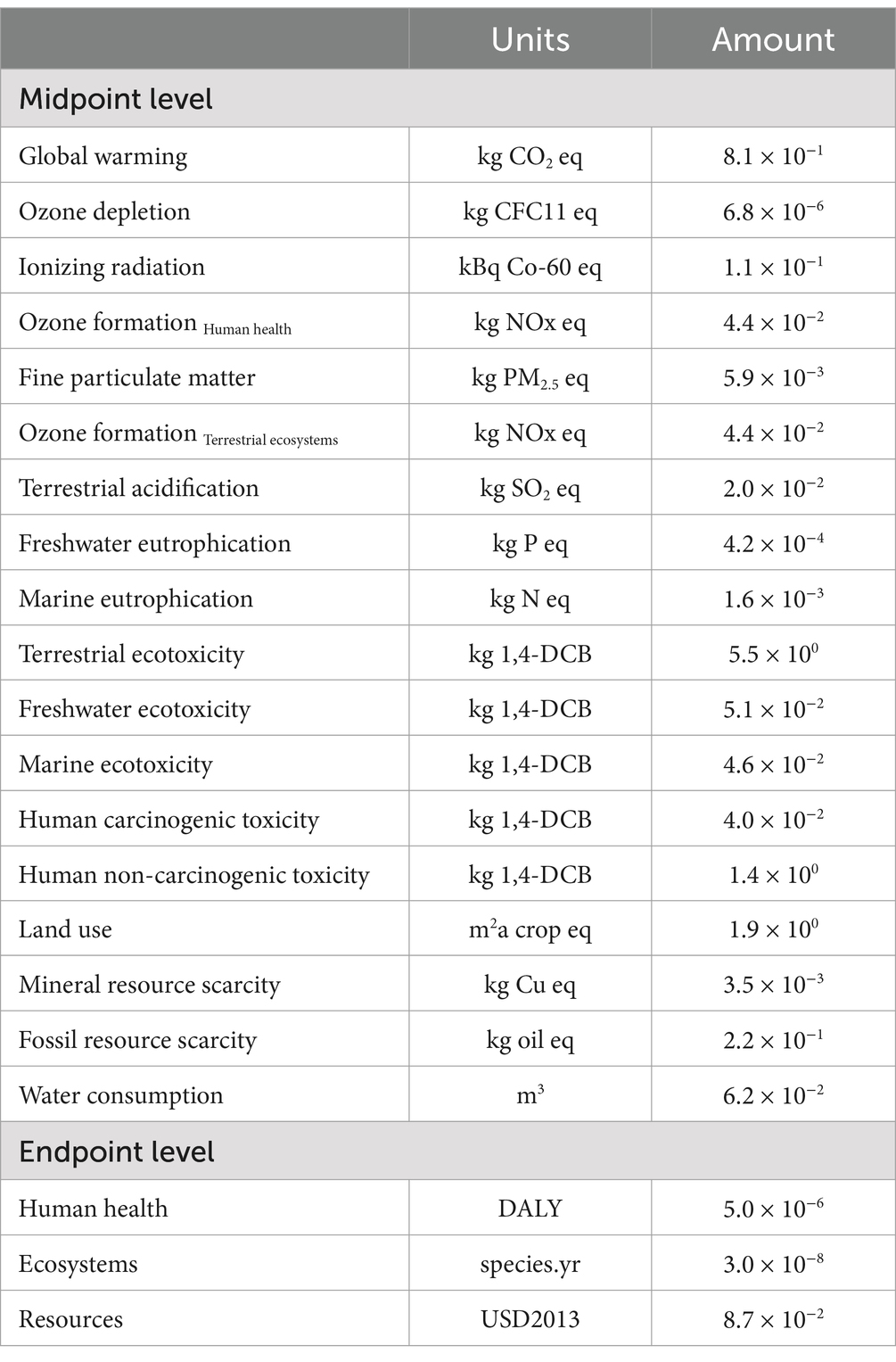
Table 11. Environmental impact per kg rye bread in the different midpoint-and endpoint-level categories assessed.
Production of ingredients was found to be the most influential process with respect to all environmental impact categories (Figure 3). Transportation, distribution and packaging were the second most important processes, but differed in importance depending on the environmental impact category considered. With respect to total climate impact the cultivation represented 33% of impact, while production of ingredients and the use of packaging accounted for 41 and 21% of impact, respectively. The system expansion for side streams, especially process pathways that avoided diesel production, had a considerable substitution effect on most impact categories. Avoiding production of materials due to recycling of packaging also showed a high influence on reduced impact with respect to climate, eutrophication and fossil resource scarcity. Supporting results for all impact categories are available in Table S6.
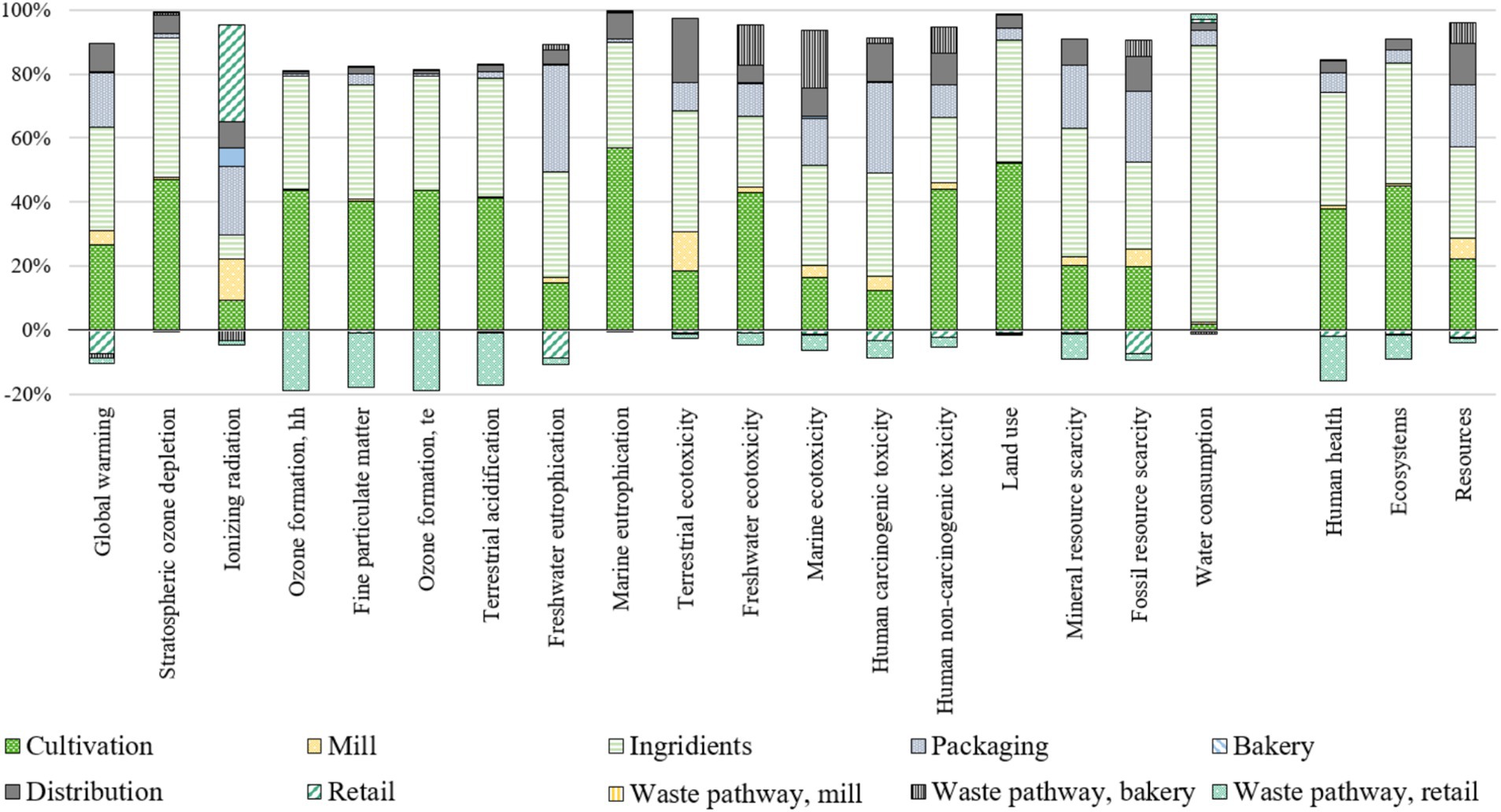
Figure 3. Environmental impact in different impact categories of each process in production and distribution of 1 kg rye bread. The 18 impact categories at midpoint (left) and the three damage categories at endpoint (right).
Several scenario analyses were performed, and all resulted in lower climate impact than the current system (Figure 2). Prevention of surplus at bakery and retail, alongside shifting to organic cultivation of wheat and rye, were found to confer the greatest environmental savings with respect to climate impact. The lowest reduction in climate impact was found for shifting to EURO 6. Compared to the current base case, shifting to organic cultivation, EURO 6 in transports, and prevention of surplus resulted in 7, 1, and 8% lower impact, respectively. Supporting results for total impact of each scenario with respect to all impact categories are available in Table S7.
4 Discussion
One of the main outcomes of the independent collaboration between industry and research conducted in this study was in-depth mapping and analysis of the resources required to produce rye bread at industrial level in Sweden. The results, validated by industry actors, provide unique insights into bread production, which is an essential cornerstone for future research and development of sustainable food systems.
The environmental impact of whole-grain rye bread (Rågkusar) in terms of climate impact was found to be 0.81 kg CO2eq per kg bread, which is in line with previous findings. In their study assessing environmental benefits of prevention and valorisation for surplus bread in Sweden, Bartek et al. (2025) found a climate impact of 1 kg CO2eq per kg pre-packaged bread. However, their study did not account for the contribution from packaging, which was done in the present study. Furthermore, their study used a national approach including all pre-packaged bread sold at retail and distributed under TBA, and thus did not model the pathways based on a specific product. Jensen and Arlbjørn (2014) estimated a climate impact of 0.73 kg CO2eq for Danish rye bread, while Nielsen et al. (2003) found that 1 kg of rye bread contributed 0.79 kg CO2eq and 1 kg wheat bread contributed 0.84 kg CO2eq. The differences in carbon footprint between these previous results and the present one could be due to differences in scope, newer datasets, or methodological differences regarding, e.g., multifunctionality or burden allocation. Moreover, the present study accounted for the valorisation benefits of side-streams and surplus, alongside packaging, which has previously often been excluded in LCA studies for bread. Although the rye bread product assessed in this study was found to have a slightly lower environmental impact than previously reported, it is important to note that the results are based on inputs for one product, produced in Sweden, with the majority of the data provided by an industry partner. This provided valuable insights into actual production and management of rye bread, but also infers important limitations related to generalizability of the results.
One key limitation of this study is that it does not account for variability in input data, since the system describes the production of a specific product, thus, comparisons of results should consider this aspect since the modeling assumptions strongly influence the environmental performance. The life cycle model relies on input data that may vary considerably depending on local production practices, climatic conditions, and agricultural inputs. For instance, variations in farming techniques or regional differences in fertilizer use and irrigation practices could influence the environmental impacts of whole-grain rye bread. While the data used in this study were derived from an industry partner in Sweden, it is possible that similar products produced in other regions could exhibit different environmental impacts due to these factors. Consequently, the findings of this study should be interpreted with caution when applied to other contexts with differing agricultural or production systems. Moreover, in countries with more intensive farming practices or less bread waste directed towards anaerobic incineration that can substitute diesel fuels, the environmental footprint of bread could be drastically different. A similar conclusion was also presented by Tripathi and Mishra (2024) and Bartek et al. (2025). The transferability of the findings to different geographical contexts, with varying supply chains and consumption patterns, requires further investigation. The assumptions underlying the LCA model could also be refined by considering alternative agricultural practices, packaging innovations, and broader sustainability indicators such as economic or social aspects. It is important to also note that while the study emphasizes the role of ingredient production and packaging in the environmental footprint of bread, other factors, such as consumer behavior and food waste at the household level, also warrant consideration with respect to the entire bread supply chain. Future studies could integrate these elements into the model to provide a more holistic view of the environmental impacts associated with bread production and consumption. While this study provides a valuable foundation for understanding the environmental impacts of whole-grain bread production, it is crucial to acknowledge the limitations of the model and the variability of the data. These considerations should guide the interpretation of the results and underscore the need for future research to assess the broader applicability and potential improvements to the model in diverse geographical contexts.
The most impactful process identified in this study was cultivation of wheat and rye, which is in line with previous findings (Jensen and Arlbjørn, 2014; Notarnicola et al., 2017). Type of grain and flour used also strongly influenced the environmental performance of the bread, since whole-grain flour and rye flour have a lower impact than wheat flour (Espinoza-Orias et al., 2011; Nielsen et al., 2003). In addition, cultivation system had a strong influence on the environmental performance of bread, since organic cultivation was found to reduce the impact by over 7% (Figure 2). This is somewhat contradictory to previous findings of increasing environmental impact with increasing proportion of organic grain (Meier et al., 2015). However, our scenario analysis only evaluated the climate aspect of organic and non-organic cultivation and future studies would likely benefit from including additional impact categories, to capture potential trade-offs that were not identifiable in the present study. Furthermore, it is reasonable to argue that Rågkusar, which have a high proportion of rye and whole-grain in the recipe, have a lower environmental impact than products with a higher proportion of wheat. Another process that has previously been identified as a climate impact hotspot is energy consumption in baking (Braschkat et al., 2003; Jensen and Arlbjørn, 2014), but our results indicated that this process made a negligible contribution in all impact categories (Figure 3). This is likely because the energy sources were Swedish electricity and heat, which are based on a high proportion of renewable energy. Another contributing factor could be that the inputs were modelled based on small bread rolls (Rågkusar), baked separately, which requires less energy than large loaves due to the larger relative surface area exposed. The distribution chain from bakery to retail also had notable influence on the environmental impact for Swedish rye bread, which is in line with previous findings (Weber et al., 2023). This was especially relevant with respect to climate impact, however only a slight reduction in impact was obtained when simulating EURO 6 transport. This might be due to the datasets used to model transportation, since the emissions allowed using EURO 5 road transport are only slightly reduced when assuming the highest EURO class (Figure 2). Instead of baking being a hotspot for impact, in this study packaging had a considerable influence on the results, especially with respect to climate impact, eutrophication and fossil resource scarcity (Figure 3). Packaging inputs contributed to roughly 25% of the total climate impact per kg rye bread, requiring both raw materials and transportation. This highlights the importance of accounting for packaging when assessing bread, especially pre-packaged bread. Packaging is often omitted in LCA studies on food, so the results obtained in this study could provide a valuable foundation for future studies.
Fazer already has a set of in-house goals on grain use, including several steps for ensuring sustainably produced grain. In interviews, Fazer (2023) highlighted potential roadblocks for shifting towards organic cultivation. These include a risk of lower yields per hectare (Braschkat et al., 2003), which would potentially lead to reduced food security and increased competition for arable land if all cultivation were organic. Another roadblock to organic cultivation is the current price of organic grain, which can be 50% more expensive than conventional grain. Shifting to organic cultivation would thus increase the price of bread, which might compromise consumer satisfaction. This is especially relevant since the demand for organic products has decreased (Fazer, 2022c). Fazer representatives reported that they had expanded their line of organic breads in the past, but that these products did not sell as well as their non-organic bread products, potentially due to the higher price. A more efficient strategy to reduce the impact of rye bread could be to reduce the surplus generated at bakery and retail, preferably via prevention pathways. This was also found to be an important aspect for less damage to ecosystems (Figure 3).
The retail surplus side-stream for Rågkusar was found to be 10%, currently directed towards ethanol production, while an additional 6% is generated at the bakery and directed towards animal feed or biogas. In total, the supplier-retailer interface is responsible for roughly 165 g surplus per kg rye bread. This amounts to a loss rate of roughly 17%, including finished products, dough scraps, flour etc. In order to illustrate the potential economic losses, it was assumed that all losses have the same value as the finished product. The current retail price of Rågkusar is roughly 30 SEK (2.60 EUR) per 338 g pack. Using the annual production volume of 1,200 ton, the surplus represents losses of 198 ton equating to annual economic losses of roughly 18 million SEK (or 1.5 million EUR). During the interviews, several factors were mentioned as drivers of surplus generated at the bakery, including damaged products, sub-standard quality and food security challenges (Fazer, 2022b). A 6% loss at bakery level can be considered quite low but, considering that additional losses that occur at retail, it is reasonable to assume that considerable environmental, social and economic gains would be possible if this waste could be prevented or directed towards, e.g., human consumption. In a scenario with 50% loss prevention at bakery and retail, the climate impact per kg bread was reduced by over 8%. This would also provide an economic gain, since less inputs are needed per unit of bread produced when less is wasted. Fazer (2023) reported that they have evaluated several actions with potential to reduce surplus bread, including price reductions, optimised shelving that requires less bread to provide a feeling of abundance, and solutions for matching supply with demand. The reduction potential of these actions and their plausible environmental benefits should be assessed in future research.
Based on these results, several practical mitigation strategies could be implemented to reduce the environmental impact of whole-grain bread production in Sweden. Improvements in packaging, such as using more sustainable materials or reducing packaging weight, could mitigate the environmental footprint. Another potential strategy includes optimizing ingredient sourcing and production processes to minimize waste and energy consumption, especially within the ingredient production phase. Reducing surplus generated during bakery and retail operations would greatly contribute to increased sustainability within the bread sector, especially if waste is prevented or surplus circulated to human nutrition by, for instance, development of novel products using bakery side-streams, or via food donations and price reductions for surplus at retail. To support such innovations or incentives to reduce food waste, policy recommendations could play an important role alongside stakeholder engagement. A similar discussion was also voiced by Eriksson et al. (2025) with respect to food waste, using bread as example. The novel in-depth mapping of whole-grain rye bread production in Sweden, alongside its environmental impact, enabled through the independent collaboration between industry and research, not only offers insights for immediate improvements by actors within the bread supply chain, but also lays the groundwork for future research into more sustainable food production practices. Future research would benefit from including a deeper exploration of the benefits attributed to mitigation pathways and its environmental impact, such as redistribution of unsold bread to reduce food waste or reuse in secondary products. Additionally, future studies would benefit from also accounting for the social and economic implications of actions targeted to reduce waste and support sustainable food systems.
5 Conclusion
This study assessed the environmental impact of rye bread produced in Sweden, using a broad range of impact categories to capture multiple environmental aspects. In order to determine the environmental impact of rye bread with greater accuracy, the assessment was performed in collaboration with an industry actor, using primary production data for one of their rye bread products as modelling input to the life cycle assessment. The results revealed that rye bread had a climate impact of 0.81 kg CO2eq per kg, with production of ingredients identified as the main environmental hotspot for all impact categories assessed. Packaging, a process often omitted in LCA studies on food, was found to make considerable contributions to climate impact, eutrophication and fossil resource scarcity. Shifting from conventional to organic cultivation of wheat and rye, or reducing the surplus generated at bakery and retail by 50%, both resulted in roughly 8% lower climate impact. A novel outcome from this study was the in-depth mapping of whole-grain rye bread production and its environmental impact enabled through independent collaboration between industry and research. The results provide an important foundation for future research and development within sustainable production of food.
Data availability statement
The original contributions presented in the study are included in the article/Supplementary material, further inquiries can be directed to the corresponding author.
Author contributions
SH: Conceptualization, Data curation, Investigation, Methodology, Software, Validation, Visualization, Writing – original draft, Writing – review & editing. LB: Conceptualization, Methodology, Software, Supervision, Visualization, Writing – original draft, Writing – review & editing. PB: Software, Supervision, Validation, Writing – original draft, Writing – review & editing. ME: Funding acquisition, Project administration, Supervision, Writing – original draft, Writing – review & editing. HK: Funding acquisition, Methodology, Supervision, Writing – original draft, Writing – review & editing. IS: Formal analysis, Validation, Writing – original draft, Writing – review & editing.
Funding
The author(s) declare that financial support was received for the research and/or publication of this article. This work was supported by the H2020 project LOWINFOOD (multi-actor design of low-waste food value chains through the demonstration of innovative solutions to reduce food loss and waste), which is funded by the European Union’s Horizon 2020 research and innovation programme under grant agreement no. 101000439. This work is also supported by Mistra Food Futures (DIA 2018/24#8), a research programme funded by Mistra (The Swedish Foundation for Strategic Environmental Research). The views reflected in this article represent the professional views of the authors and do not necessarily reflect the views of the European Commission, other LOWINFOOD or Mistra project partners.
Conflict of interest
The authors declare that the research was conducted in the absence of any commercial or financial relationships that could be construed as a potential conflict of interest.
Generative AI statement
The author(s) declare that no Gen AI was used in the creation of this manuscript.
Publisher’s note
All claims expressed in this article are solely those of the authors and do not necessarily represent those of their affiliated organizations, or those of the publisher, the editors and the reviewers. Any product that may be evaluated in this article, or claim that may be made by its manufacturer, is not guaranteed or endorsed by the publisher.
Supplementary material
The Supplementary material for this article can be found online at: https://www.frontiersin.org/articles/10.3389/fsufs.2025.1528862/full#supplementary-material
References
Bartek, L., Sjölund, A., Brancoli, P., Cicatiello, C., Mesiranta, N., Närvänen, E., et al. (2025). The power of prevention and valorisation – environmental impacts of reducing surplus and waste of bakery products at retail. Sustain. Product. Consumpt. 55, 51–62. doi: 10.1016/j.spc.2025.01.013
Blomhoff, R., Andersen, R., Arnesen, E., Christensen, J., Eneroth, H., and Erkkola, M. (2023). Nordic nutrition recommendations 2023/integrating environmental aspects. Available online at: https://pub.norden.org/nord2023-003/nord2023-003.pdf [2024-07-16]
Brancoli, P., Bolton, K., and Eriksson, M. (2020). Environmental impacts of waste management and valorisation pathways for surplus bread in Sweden. Waste Manag. 117, 136–145. doi: 10.1016/j.wasman.2020.07.043
Brancoli, P., Lundin, M., Bolton, K., and Eriksson, M. (2019). Bread loss rates at the supplier-retailer interface – analysis of risk factors to support waste prevention measures. Resour. Conserv. Recycl. 147, 128–136. doi: 10.1016/j.resconrec.2019.04.027
Braschkat, J., Patyk, A., Quirin, M., and Reinhardt, G. A. (2003). Life cycle assessment of bread production—a comparison of eight different scenarios. Available online at: https://lcafood.dk/lca_conf/DJFrapport_paper_2_poster.pdf#page=9 [2024-07-16]
Cassarino, M., Giuberti, G., Morelli, L., Trezzi, M., Pelattieri, A., Manicardi, L., et al. (2024). nLCA in bakery food products: state of the art and urgent needs. Front. Sustain. Food Syst. 8, 6. doi: 10.3389/fsufs.2024.1253865
Crenna, E., Sinkko, T., and Sala, S. (2019). Biodiversity impacts due to food consumption in Europe. J. Clean. Prod. 227, 378–391. doi: 10.1016/j.jclepro.2019.04.054
Cust, A. E., Skilton, M. R., van Bakel, M. M. E., Halkjaer, J., Olsen, A., Agnoli, C., et al. (2009). Total dietary carbohydrate, sugar, starch and fibre intakes in the European prospective investigation into Cancer and nutrition. Eur. J. Clin. Nutr. 63, S37–S60. doi: 10.1038/ejcn.2009.74
de los Mozos, E. A., Badurdeen, F., and Dossou, P.-E. (2020). Sustainable consumption by reducing food waste: a review of the current state and directions for future research. Proc. Manufact. 51, 1791–1798. doi: 10.1016/j.promfg.2020.10.249
Eriksson, M., Bartek, L., Sturén, F., Christensen, J., Cicatiello, C., Giordano, C., et al. (2025). From surplus to sustainability: the role of legislation in reducing climate impact from Swedish bread waste. SSRN Scholarly Paper, Social Science Research Network.
Eriksson, M., Ghosh, R., Mattsson, L., and Ismatov, A. (2017). Take-back agreements in the perspective of food waste generation at the supplier-retailer interface. Resour. Conserv. Recycl. 122, 83–93. doi: 10.1016/j.resconrec.2017.02.006
Espinoza-Orias, N., Stichnothe, H., and Azapagic, A. (2011). The carbon footprint of bread. Int. J. Life Cycle Assess. 16, 351–365. doi: 10.1007/s11367-011-0271-0
Fazer (2022d). Fazer Årsredovisning 2022. Available online at: https://www.fazer.fi/globalassets/fazer-group/pdfs/arsredovisning-2022.pdf#page=14 [2023-04-12]
Fazer’s Supplier (2022b). Fazer’s supplier [4]. October 17, 2022; November 7, 2022; November 25, 2022.
Gibson, M., and Gibson, A. (2024). Assessing priorities for food systems transformation among UK alternative actors. Environ. Res. 1:025005. doi: 10.1088/2976-601X/ad73dc
Goryńska-Goldmann, E. (2022). Bread and other bakery and confectionery products waste in selected retail stores. Ann. Polish Assoc. Agric. Agribus. Econ. XXIV, 65–79. doi: 10.5604/01.3001.0016.1148
Goucher, L., Bruce, R., Cameron, D. D., Lenny Koh, S. C., and Horton, P. (2017). The environmental impact of fertilizer embodied in a wheat-to-bread supply chain. Nat. Plants 3, 1–5. doi: 10.1038/nplants.2017.12
Heydari, M. (2024). Cultivating sustainable global food supply chains: a multifaceted approach to mitigating food loss and waste for climate resilience. J. Clean. Prod. 442:141037. doi: 10.1016/j.jclepro.2024.141037
Ingrao, C., Licciardello, F., Pecorino, B., Muratore, G., Zerbo, A., and Messineo, A. (2018). Energy and environmental assessment of a traditional durum-wheat bread. J. Clean. Prod. 171, 1494–1509. doi: 10.1016/j.jclepro.2017.09.283
ISO 14040 (2006). ISO 14040:2006, Environmental management — Life cycle assessment — Principles and framework. Avaialble online at: https://www.iso.org/obp/ui#iso:std:iso:14040:ed-2:v1:en [2024-07-16]
Jensen, J. K., and Arlbjørn, J. S. (2014). Product carbon footprint of rye bread. J. Clean. Prod. 82, 45–57. doi: 10.1016/j.jclepro.2014.06.061
Jordbruksverket (2023). Direktkonsumtion efter Vara, Variabel och År. PxWeb. Available online at: http://statistik.sjv.se/PXWebPXWeb/pxweb/sv/jordbruksverketsstatistikdatabas/jordbruksverketsstatistikdatabas__konsumtion%20av%20livsmedel/JO1301K1.px/ [2023-03-20]
Kramer, G. F. H., Martinez, E. V., Espinoza-Orias, N. D., Cooper, K. A., Tyszler, M., and Blonk, H. (2018). Comparing the performance of bread and breakfast cereals, dairy, and meat in nutritionally balanced and sustainable diets. Front. Nutr. 5:51. doi: 10.3389/fnut.2018.00051
Kustar, A., and Patino-Echeverri, D. (2021). A review of environmental life cycle assessments of diets: plant-based solutions are truly sustainable, even in the form of fast foods. Sustain. For. 13:9926. doi: 10.3390/su13179926
Kyrø, C., Skeie, G., Dragsted, L. O., Christensen, J., Overvad, K., Hallmans, G., et al. (2012). Intake of whole grain in Scandinavia: intake, sources and compliance with new national recommendations. Scand. J. Public Health 40, 76–84. doi: 10.1177/1403494811421057
Meier, M. S., Stoessel, F., Jungbluth, N., Juraske, R., Schader, C., and Stolze, M. (2015). Environmental impacts of organic and conventional agricultural products – are the differences captured by life cycle assessment? J. Environ. Manag. 149, 193–208. doi: 10.1016/j.jenvman.2014.10.006
Mekonnen, M. M., and Gerbens-Leenes, W. (2020). The water footprint of global food production. Water 12:2696. doi: 10.3390/w12102696
Molina-Besch, K., Wikström, F., and Williams, H. (2019). The environmental impact of packaging in food supply chains—does life cycle assessment of food provide the full picture? Int. J. Life Cycle Assess. 24, 37–50. doi: 10.1007/s11367-018-1500-6
Moores, A., Charalampopoulos, D., Williams, A., and Schmidt Rivera, X. (2025). Incorporating circularity, sustainability, and systems thinking into an assessment framework for transformative food system innovation. Front. Sustain. Food Syst. 8, 15. doi: 10.3389/fsufs.2024.1502468
Nielsen, P. H., Nielsen, A. M., Weidema, B. P., Dalgaard, R., and Halberg, N. (2003). LCA food data base. Available online at: https://lca-net.com/publications/show/lca-food-data-base/ [2024-07-17]
Notarnicola, B., Tassielli, G., Renzulli, P. A., and Monforti, F. (2017). Energy flows and greenhouses gases of EU (European Union) national breads using an LCA (life cycle assessment) approach. J. Clean. Prod. 140, 455–469. doi: 10.1016/j.jclepro.2016.05.150
Poore, J., and Nemecek, T. (2018). Reducing food’s environmental impacts through producers and consumers. Science 360, 987–992. doi: 10.1126/science.aaq0216
Ritchie, H., Rosado, P., and Roser, M. (2024). Greenhouse gas emissions. Our World in Data,. https://ourworldindata.org/greenhouse-gas-emissions [2024-07-16]
Rockström, J., Edenhofer, O., Gaertner, J., and DeClerck, F. (2020). Planet-proofing the global food system. Nat. Food 1, 3–5. doi: 10.1038/s43016-019-0010-4
Scherhaufer, S., Davis, J., Metcalfe, P., Gollnow, S., Colin, F., De Menna, F., et al. (2020). Environmental assessment of the valorisation and recycling of selected food production side flows. Resour. Conserv. Recycl. 161:104921. doi: 10.1016/j.resconrec.2020.104921
Springmann, M., Clark, M., Mason-D’Croz, D., Wiebe, K., Bodirsky, B. L., Lassaletta, L., et al. (2018). Options for keeping the food system within environmental limits. Nature 562, 519–525. doi: 10.1038/s41586-018-0594-0
Steffen, W., Richardson, K., Rockström, J., Cornell, S. E., Fetzer, I., Bennett, E. M., et al. (2015). Planetary boundaries: guiding human development on a changing planet. Science 347:1259855. doi: 10.1126/science.1259855
Sundkvist, Å., Jansson, A., and Larsson, P. (2001). Strengths and limitations of localizing food production as a sustainability-building strategy — an analysis of bread production on the island of Gotland, Sweden. Ecol. Econ. 37, 217–227. doi: 10.1016/S0921-8009(00)00277-9
Svanes, E., Oestergaard, S., and Hanssen, O. J. (2019). Effects of packaging and food waste prevention by consumers on the environmental impact of production and consumption of bread in Norway. Sustainability (Switzerland) 11. doi: 10.3390/su11010043
Tripathi, I., and Mishra, V. (2024). “Circular bioeconomy of baked food products” in Biological outlook to improve the nutritive quality of bakery products. eds. G. Sanghvi, N. K. Singh, A. K. Bishoyi, and S. J. Joshi (Springer Nature), 103–123.
United Nations Environment Programme (2024). Food Waste Index Report 2024. Available online at: https://eur-lex.europa.eu/eli/dir/2018/851/oj [2022-10-13]
Vidergar, P., Perc, M., and Lukman, R. K. (2021). A survey of the life cycle assessment of food supply chains. J. Clean. Prod. 286:125506. doi: 10.1016/j.jclepro.2020.125506
Keywords: life cycle assessment, bread inventory, surplus pathways, sustainable production, climate impact
Citation: Hildersten S, Bartek L, Brancoli P, Eriksson M, Karlsson Potter H and Strid I (2025) Mapping the climate impact of rye bread production in Sweden: insights into cultivation, packaging, and surplus management for sustainable food systems. Front. Sustain. Food Syst. 9:1528862. doi: 10.3389/fsufs.2025.1528862
Edited by:
Abdalbasit Adam Mariod, Jeddah University, Saudi ArabiaReviewed by:
Elio Romano, Centro di ricerca per l’Ingegneria e le Trasformazioni agroalimentari (CREA-IT), ItalyAulia Ulfah Farahdiba, Universitas Pembangunan Nasional Veteran Jawa Timur, Indonesia
Copyright © 2025 Hildersten, Bartek, Brancoli, Eriksson, Karlsson Potter and Strid. This is an open-access article distributed under the terms of the Creative Commons Attribution License (CC BY). The use, distribution or reproduction in other forums is permitted, provided the original author(s) and the copyright owner(s) are credited and that the original publication in this journal is cited, in accordance with accepted academic practice. No use, distribution or reproduction is permitted which does not comply with these terms.
*Correspondence: L. Bartek, bG91aXNlLmJhcnRla0BzbHUuc2U=
 S. Hildersten1
S. Hildersten1 L. Bartek
L. Bartek P. Brancoli
P. Brancoli I. Strid
I. Strid